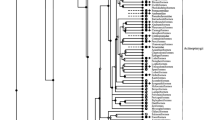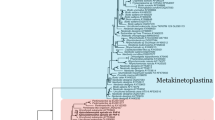Abstract
Creatine kinase (CK) plays a central role in energy homeostasis in cells that display high and variable rates of energy turnover. A number of CK genes exist, each being targeted to particular intracellular compartments. In the vertebrates, two genes code for proteins which form homo- and heterodimers targeted to the cytoplasm, while two additional genes code for primarily octameric proteins targeted to the mitochondrial intermembrane space. Yet another gene is present in certain groups which codes for three fused, complete CK domains and is typically targeted to the flagellar membrane of primitive-type spermatozoa. CK is widely distributed in protochordates and both protostome and deuterostome invertebrate groups. The evolutionary relationships of these CK genes have not been fully elucidated. The present communication reports new cDNA-derived deduced amino acid sequences for four cytoplasmic and three mitochondrial CKs and one flagellar CK from lophotrochozoan, protostome invertebrates as well as a new cytoplasmic CK sequence from a protochordate tunicate. These new sequences, coupled with available sequences in the databases and sequences extracted from genome sequencing projects, provide revealing insights into the evolution and divergence of CK genes. Phylogenetic analyses showed that single cytoplasmic, mitochondrial, and flagellar CK genes were present prior to the divergence of the protostomes and deuterostomes. The flagellar CK gene may have evolved within the cytoplasmic gene clade, although the evidence is somewhat equivocal. The two cytoplasmic genes in the vertebrates, and most likely the two mitochondrial genes, evolved after the divergence of the craniates from the protochordates. Comparison of the structure of the genes for selected cytoplasmic, mitochondrial, and flagellar CKs revealed two identical intron boundaries, further reinforcing the notion of a common evolutionary origin, but also showed patterns of changes in structure consistent with each gene type. These studies show that the cytoplasmic, mitochondrial, and flagellar CK genes are rather ancient and that there has been a systematic pattern of duplication and divergence consistent with changing nature of energy demands and physicochemical environment in the cells where they are expressed.




Similar content being viewed by others
References
ND Borson WL Salo LR Drewes (1992) ArticleTitleA lock-docking oligo (DT) primer for 5’ and 3’ RACE PCR PCR Methods Appl 2 144–148 Occurrence Handle1:CAS:528:DyaK3sXhtFOls74%3D Occurrence Handle1477669
P Chomczynski N Sacchi (1987) ArticleTitleSingle-step method of RNA isolation by acid guanidinium thiocyanate-phenol-chloroform extraction Anal Biochem 162 156–159 Occurrence Handle10.1006/abio.1987.9999 Occurrence Handle1:CAS:528:DyaL2sXitFSns7Y%3D Occurrence Handle2440339
P Dehal Y Satou RK Campbell et al. (2002) ArticleTitleThe draft genome of Ciona intestinalis: Insights into chordate and vertebrate origins Science 298 2157–2167 Occurrence Handle10.1126/science.1080049 Occurrence Handle1:CAS:528:DC%2BD38XpsVSkt7o%3D Occurrence Handle12481130
WR Ellington (2001) ArticleTitleEvolution and physiological roles of phosphagen systems Annu Rev Physiol 63 289–325 Occurrence Handle1:CAS:528:DC%2BD3MXjtFKmtLg%3D Occurrence Handle11181958
D-F Feng RF Doolittle (1987) ArticleTitleProgressive sequence alignments as a prerequisite to correct phylogenetic trees J Mol Evol 25 351–360 Occurrence Handle1:CAS:528:DyaL1cXhsl2kuw%3D%3D Occurrence Handle3118049
MA Frohman MK Dush GR Martin (1988) ArticleTitleRapid production of full length cDNAs from rare transcripts: Amplification using a single gene-specific primer Proc Natl Acad Sci USA 85 8998–9002 Occurrence Handle1:CAS:528:DyaL1MXntVCmtQ%3D%3D Occurrence Handle2461560
NA Graber WR Ellington (2001) ArticleTitleGene duplication events producing muscle (M) and brain (B) isoforms of cytoplasmic creatine kinase: cDNA and deduced amino acid sequences from two lower chordates Mol Biol Evol 18 1305–1314 Occurrence Handle1:CAS:528:DC%2BD3MXltVGru7w%3D Occurrence Handle11420369
SC Klein RC Haas MB Perryman JJ Billadello AW Strauss (1991) ArticleTitleRegulatory element analysis and structural characterization of the human sarcomeric mitochondrial creatine kinase gene J Biol Chem 266 18058–18065 Occurrence Handle1:CAS:528:DyaK3MXlt1yqt7o%3D Occurrence Handle1917943
E Mariman B Wieringa (1991) ArticleTitleExpression of the gene encoding human brain creatine kinase depends on sequences immediately following the transcription start point Gene 102 205–212 Occurrence Handle1:CAS:528:DyaK3MXlsFags7g%3D Occurrence Handle1840537
SM Mühlebach M Gross T Wirz T Wallimann J-C Perriard M Wyss (1994) ArticleTitleSequence homology and structure predictions of the creatine kinase isoenzymes Mol Cell Biochem 133/134 245–262
AO Pineda WR Ellington (1999) ArticleTitleStructural and functional implications of the amino acid sequences of dimeric, cytoplasmic and octameric, mitochondrial creatine kinases from a protostome invertebrate Eur J Biochem 264 67–73 Occurrence Handle1:CAS:528:DyaK1MXlsVyrtrY%3D Occurrence Handle10447674
AO Pineda SuffixJr WR Ellington (2001) ArticleTitleOrganization of the gene for an invertebrate mitochondrial creatine kinase: Comparisons with genes of higher forms and correlation of exon boundaries with functional domains Gene 265 115–121 Occurrence Handle1:CAS:528:DC%2BD3MXhsleksb8%3D Occurrence Handle11255014
W Qin Z Khuchua J Cheng J Boero RM Payne AW Strauss (1998) ArticleTitleMolecular characterization of the creatine kinases and some histrorical perspectives Mol Cell Biochem 184 153–167 Occurrence Handle1:STN:280:DyaK1cvhslCjsw%3D%3D Occurrence Handle9746319
AFG Quest DJ Harvey RAJ McIlhinney (1997) ArticleTitleMyristoylated and non myristoylated pools of sea urchin sperm flagellar creatine kinase exist side-by-side: Myristoylation is necessary for efficient lipid association Biochemistry 36 6993–7002 Occurrence Handle1:CAS:528:DyaK2sXjt12gs74%3D Occurrence Handle9188696
AFG Quest JK Chadwick DD Wothe RAJ McIlhinney BM Shapiro (1992) ArticleTitleMyristoylation of flagellar creatine kinase in the sperm phosphocreatine shuttle is linked to its membrane association properties J Biol Chem 267 15080–15085 Occurrence Handle1:CAS:528:DyaK38XltVymsr4%3D Occurrence Handle1634544
A Ratto BM Shapiro R Christen (1989) ArticleTitlePhosphagen kinase evolution: expression in echinoderms Eur J Biochem 186 195–203 Occurrence Handle1:CAS:528:DyaK3cXnsVarug%3D%3D Occurrence Handle2557207
T Suzuki T Furukohri (1994) ArticleTitleEvolution of phosphagen kinase. Primary structure of glycocyamine kinase and arginine kinase from invertebrates J Mol Biol 237 353–357 Occurrence Handle1:CAS:528:DyaK2cXjtFyhtbs%3D Occurrence Handle8145248
T Suzuki Y Kawasaki T Furukohri WR Ellington (1997) ArticleTitleEvolution of phosphagen kinase VI. Isolation, characterization and cDNA-derived amino acid sequence of lombricine kinase from the earthworm Eisenia foetida, and identification of a possible candidate for the guanidine substrate recognition site Biochim Biophys Acta 1343 152–159 Occurrence Handle1:CAS:528:DyaK2sXnvVSnsr0%3D Occurrence Handle9434106
T Suzuki M Kamidochi N Inoue H Kawamichi Y Yazawa T Furukohri WR Ellington (1999) ArticleTitleArginine kinase evolved twice: Evidence that echinoderm arginine kinase originated from creatine kinase Biochem J 340 371–375 Occurrence Handle10333477
T Suzuki Y Yamamoto M Umekawa (2000) ArticleTitleStichopus japonicus arginine kinase: Gene structure and unique substrate recognition system Biochem J 351 579–585 Occurrence Handle1:CAS:528:DC%2BD3cXotF2rur0%3D Occurrence Handle11042111
RM Tombes BM Shapiro (1987) ArticleTitleEnzyme termini of the phosphocreatine shuttle J Biol Chem 262 16011–16019 Occurrence Handle1:CAS:528:DyaL2sXlvFers78%3D Occurrence Handle3680241
RM Tombes BM Shapiro (1989) ArticleTitleEnergy transport and cell polarity: Relationship of phosphagen kinase activity to sperm function J Exp Zool 251 82–90 Occurrence Handle1:CAS:528:DyaL1MXltFalsL0%3D Occurrence Handle2549169
RV Trask AW Strauss JJ Billadello (1988) ArticleTitleDevelopmental regulation and tissue-specific expression of the human muscle creatine kinase gene J Biol Chem 263 17142–17149 Occurrence Handle1:CAS:528:DyaL1cXlvVCku7w%3D Occurrence Handle2903158
K Uda T Suzuki WR Ellington (2003) ArticleTitleSome elements of the major myofibrillar binding peptide motif are present in the earliest of true muscle type creatine kinases Int J Biochem Cell Biol 36 785–794
T Wallimann M Wyss D Brdiczka K Nicolay HM Eppenberger (1992) ArticleTitleIntracellular compartmentation, structure and function of creatine kinase isoenzymes: The “phosphocreatine circuit” for cellular energy homeostasis Biochem J 281 21–40 Occurrence Handle1:CAS:528:DyaK38XjvVCjsA%3D%3D Occurrence Handle1731757
DD Wothe H Charbonneau BM Shapiro (1990) ArticleTitleThe phosphocreatine shuttle of sea urchin sperm: Flagellar creatine kinase resulted from a gene triplication Proc Natl Acad Sci USA 87 5203–5207 Occurrence Handle1:CAS:528:DyaK3cXlvVOitL0%3D Occurrence Handle2367531
M Wyss J Smeitink RA Wevers T Wallimann (1992) ArticleTitleMitochondrial creatine kinase: A key enzyme of aerobic energy metabolism Biochim Biophys Acta 1102 119–166 Occurrence Handle1:CAS:528:DyaK38XmtVOmtLc%3D Occurrence Handle1390823
Acknowledgments
T. Suzuki thanks Drs. K. Kawamura and S. Fujiwara of Kochi University for providing us the cDNA library of Polyandrocarpa misakiensis. We also thank Dr. Hajime Julie Yuasa and Sachiko Tsukamoto for assistance with sequence determination of Marphysa CK and Siphonosoma MiCK. W. R. Ellington thanks the staff of the Florida State University Cloning and DNA Sequencing Facilities for technical support in this effort. This work was supported by a grant from the President of Kochi University (to T.S.) and U.S. National Science Foundation Grant IBN-0130024 (to W.R.E.). We gratefully acknowledge the comments of two anonymous referees who provided very constructive input in the formulation of the manuscript.
Author information
Authors and Affiliations
Corresponding author
Additional information
[Reviewing Editor: Martin Kreitman]
Rights and permissions
About this article
Cite this article
Suzuki, T., Mizuta, C., Uda, K. et al. Evolution and Divergence of the Genes for Cytoplasmic, Mitochondrial, and Flagellar Creatine Kinases. J Mol Evol 59, 218–226 (2004). https://doi.org/10.1007/s00239-004-2615-x
Received:
Accepted:
Issue Date:
DOI: https://doi.org/10.1007/s00239-004-2615-x




